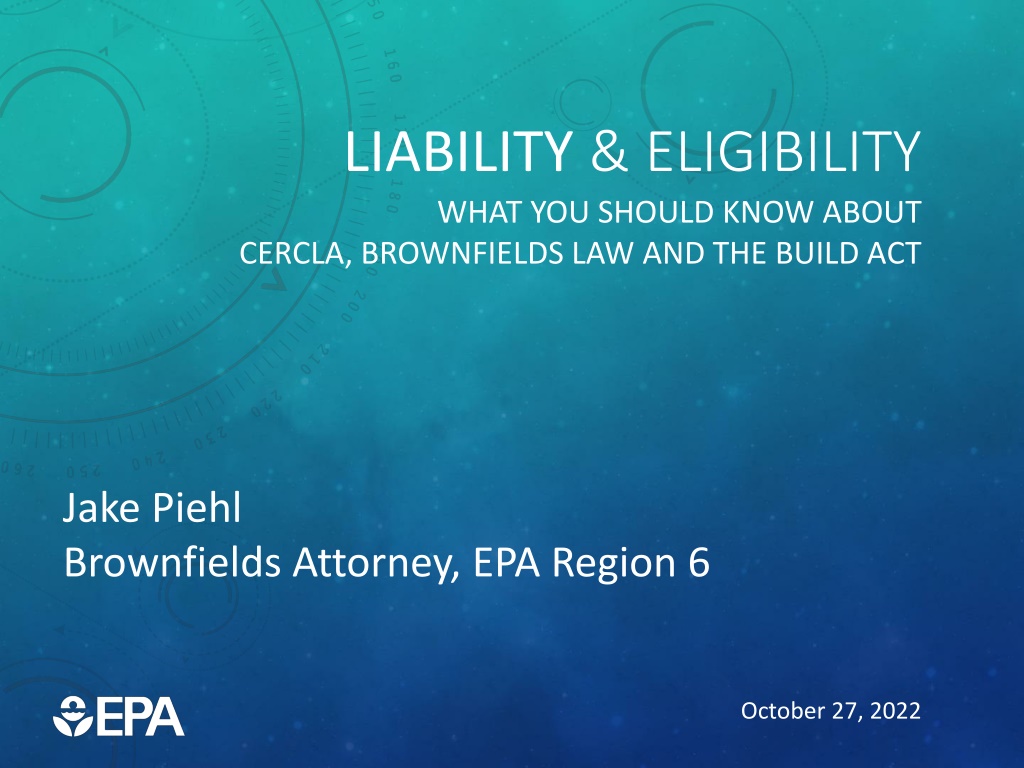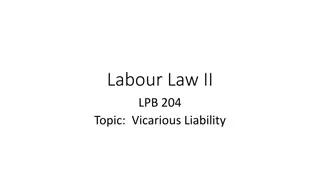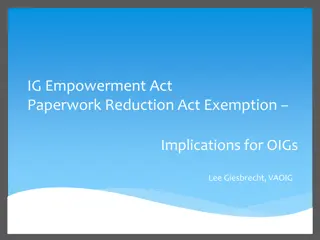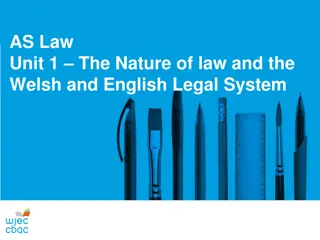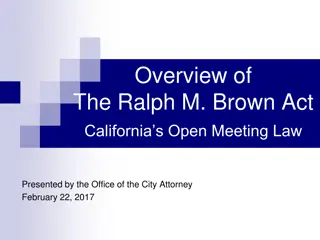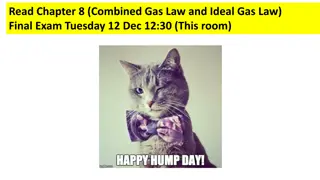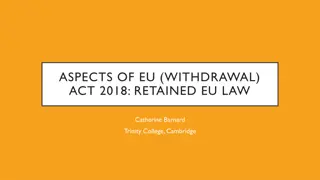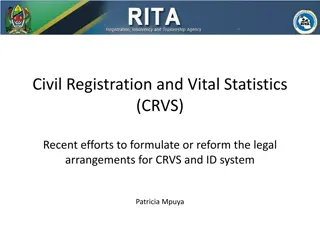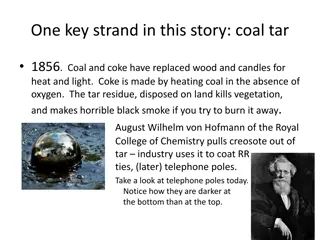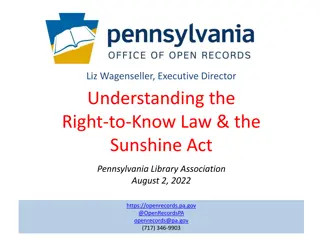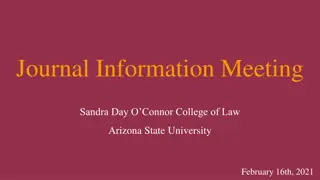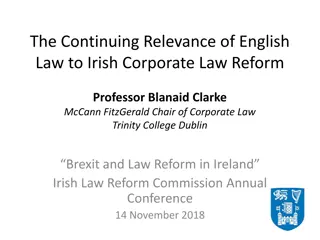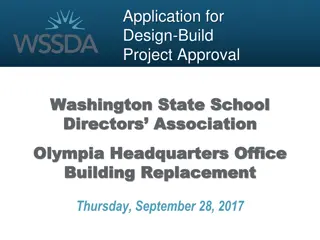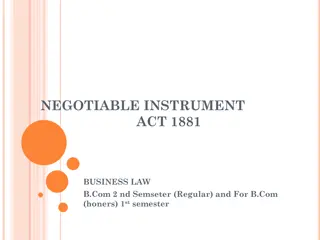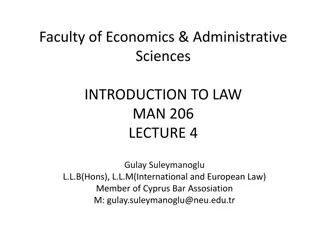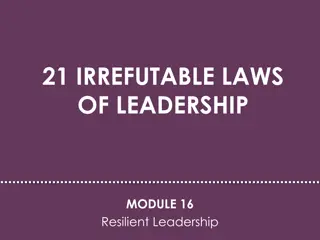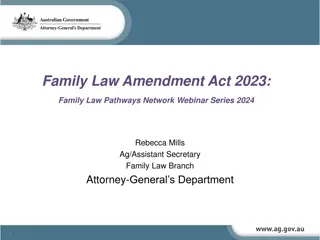Understanding CERCLA, Brownfields Law, and the BUILD Act
Explore the Comprehensive Environmental Response, Compensation, and Liability Act (CERCLA) and its implications for liability, exemptions, and potentially responsible parties. Learn how the Brownfields Law and the Small Business Liability Relief Act provide protections and promote revitalization of contaminated sites. Gain insights into eligibility criteria, liability thresholds, and exceptions under these environmental regulations.
Download Presentation

Please find below an Image/Link to download the presentation.
The content on the website is provided AS IS for your information and personal use only. It may not be sold, licensed, or shared on other websites without obtaining consent from the author. Download presentation by click this link. If you encounter any issues during the download, it is possible that the publisher has removed the file from their server.
E N D
Presentation Transcript
LIABILITY & ELIGIBILITY WHAT YOU SHOULD KNOW ABOUT CERCLA, BROWNFIELDS LAW AND THE BUILD ACT Jake Piehl Brownfields Attorney, EPA Region 6 October 27, 2022
OVERVIEW CERCLA Background CERCLA Liability Protections and Exemptions Brownfields Grant Eligibility Brownfields Liability Threshold Questions
COMPREHENSIVE ENVIRONMENTAL RESPONSE, COMPENSATION & LIABILITY ACT ( CERCLA )(1980) 42 U.S.C. 9601 ET SEQ. AKA "SUPERFUND LAW" Established an environmental liability scheme Provided protection from liability for certain entities Established a due diligence standard necessary to obtain liability protection
Current owner/operator of the site Owner/operator of a site at the time of disposal Person who arranged for the disposal of a hazardous substance at a site Person who transported a hazardous substance to a site (who selected that site for disposal) CLASSES OF POTENTIALLY RESPONSIBLE PARTIES (PRPS) CERCLA 107
There are exceptions, including: De minimis / De micromis Service Station (recycled oil) Indian Tribes Municipal Solid Waste generators and transporters Secured Creditor Exemption Residential Homeowners CLASSES OF POTENTIALLY RESPONSIBLE PARTIES (PRPS) CERCLA 107
Under CERCLA, persons may be held strictly liable (without fault/culpability, just by virtue of ownership), and jointly and severally liable (held individually or collectively accountable) for cleaning up hazardous substances at properties where they own/operate, or owned/operated in the past at the time of disposal. CLASSES OF POTENTIALLY RESPONSIBLE PARTIES (PRPS) CERCLA 107
SMALL BUSINESS LIABILITY RELIEF AND BROWNFIELDS REVITALIZATION ACT (2002) AKA BROWNFIELDS AMENDMENTS Fear of potential liability prevented development Amended CERCLA to provide liability protections for landowners/potential purchasers who did not cause/contribute to contamination
SMALL BUSINESS LIABILITY RELIEF AND BROWNFIELDS REVITALIZATION ACT (2002) AKA BROWNFIELDS AMENDMENTS Defines a "Brownfield" as "real property, the expansion, redevelopment, or reuse of which may be complicated by the presence or potential presence of a hazardous substance, pollutant, or contaminant." CERCLA 101(39)(A) Also includes sites contaminated by petroleum or petroleum product, controlled substances (e.g. methamphetamine lab) and mine-scarred lands.
SMALL BUSINESS LIABILITY RELIEF AND BROWNFIELDS REVITALIZATION ACT (2002) AKA BROWNFIELDS AMENDMENTS The types of contaminants include, but are not limited to the following: Heavy metals Polynuclear aromatic hydrocarbons (PAHs) Volatile organic compounds (VOCs) Brine Asbestos
BETTER UTILIZATION OF INVESTMENTS LEADING TO DEVELOPMENT (BUILD) ACT (2018) FURTHER AMENDED CERCLA LIABILITY AND BROWNFIELDS LAW *Notable BUILD Act changes will be highlighted in GOLD
CERCLA LIABILITY PROTECTIONS AND EXEMPTIONS Innocent Landowner / Third Party Contiguous Property Owner Bona Fide Prospective Purchaser (BFPP) State and Local Governmental Entity Acquisitions
WHY ARE WE SPENDING SO MUCH TIME ON CERCLA LIABILITY? With a few exceptions (discussed later), Brownfields grant applicants must demonstrate that they are exempt from CERCLA liability to be eligible for grant funding CERCLA 104(k)
Three types of Innocent Landowners: (1) Owner that at the time of acquisition did not know and had no reason to know about the contamination at the property (shown by performing All Appropriate Inquiries or AAI, discussed later); and CERCLA LIABILITY PROTECTIONS Innocent Innocent Defense 101(35)(A) 101(35)(A) No affiliation with any liable party, other than relationship created by instrument conveying title to property. Landowners Landowners Defense **Creation of BFPP Protections essentially made this type of Innocent Landowner Defense redundant for post-Brownfields- Amendment acquisitions**
CERCLA LIABILITY PROTECTIONS (2) Governments to acquired the property involuntarily ** Expansion of State and Local Governmental Entity Acquisitions Exemptions due to BUILD Act** Innocent Innocent Defense 101(35)(A) 101(35)(A) Landowners Landowners Defense (3) Owner who acquired property by inheritance or bequest
Contamination was solely caused by: Act of God; Act of war; Acts or omissions of a third party (outside of a contractual relationship) CERCLA LIABILITY PROTECTIONS Third Third- -Party Defense Party Defense 107(b) 107(b) AND Owner must demonstrate that they exercised due care and took precautions against foreseeable acts or omissions
Owner of property contiguous (or similarly situated) to a facility that is the only source of contamination found on the property; CERCLA LIABILITY PROTECTIONS At the time of acquisition did not know and had no reason to know about the contamination at the property (AAI); Contiguous Property Contiguous Property Owners Owners Exemption Exemption 107(q)(1)(A) 107(q)(1)(A) No affiliation with any liable party; AND Meets continuing obligations (comply with land use restrictions, etc.)
Applies to purchasers with knowledge of contamination, provided the following: CERCLA LIABILITY PROTECTIONS Property was acquired after January 11, 2002; All Appropriate Inquiries (AAI) conducted prior to purchase; Not potentially liable or affiliated with potentially liable party other than relationship created by instrument conveying title to property; and Bona Fide Bona Fide Prospective Prospective Purchaser Protection Purchaser Protection 101(40) 101(40) Continuing obligations.
Applies to purchasers with knowledge of contamination, provided the following: CERCLA LIABILITY PROTECTIONS Property was acquired after January 11, 2002; All Appropriate Inquiries (AAI) conducted prior to purchase; Not potentially liable or affiliated with potentially liable party other than relationship created by instrument conveying title to property ; and Bona Fide Bona Fide Prospective Prospective Purchaser Protection Purchaser Protection 101(40) 101(40) Continuing obligations.
Applies to purchasers with knowledge of contamination, provided the following: CERCLA LIABILITY PROTECTIONS Property was acquired after January 11, 2002; All Appropriate Inquiries (AAI) conducted prior to purchase; Not potentially liable or affiliated with potentially liable party other than relationship created by instrument conveying title to property ; and Bona Fide Bona Fide Prospective Prospective Purchaser Protection Purchaser Protection 101(40) 101(40) Continuing obligations.
ALL APPROPRIATE INQUIRIES The process of evaluating a property's environmental conditions and assessing the likelihood of the presence of any contamination. **Maybe the most common stumbling block related to grant eligibility**
ALL APPROPRIATE INQUIRIES Purpose, Timing and Procedure Due Diligence (Phase I Environmental Site Assessment or equivalent) that determines prior uses and ownership of a property, and assesses the conditions of the property that may indicate releases or threatened releases of hazardous substances, contaminants or pollutants at, on, in, or to the property BEFORE a prospective purchaser acquires the real property. ASTM E1527-21 most recent standard (-13 standard still applies this award year)
ALL APPROPRIATE INQUIRIES Purpose, Timing and Procedure A Phase I ESA is an initial site assessment to identify potential presence of environmental contamination or Recognized Environmental Conditions (RECs) at the property It does NOT delineate contamination or quantify risk
FOR AAI, TIMING IS EVERYTHING Phase I or equivalent must be performed before date of acquisition Also must be performed or updated within one year prior to acquisition, some portions must be performed/updated within 180 days prior (interviews/records review/site inspection/environmental cleanup lien check)*generally just say 180 days * This requirement is regardless of whether a Phase II has been performed.
Applies to purchasers with knowledge of contamination, provided the following: CERCLA LIABILITY PROTECTIONS Property was acquired after January 11, 2002; All Appropriate Inquiries (AAI) conducted prior to purchase; Not potentially liable or affiliated with potentially liable party other than relationship created by instrument conveying title to property ; and Bona Fide Bona Fide Prospective Prospective Purchaser Protection Purchaser Protection 101(40) 101(40) Continuing obligations.
Applies to purchasers with knowledge of contamination, provided the following: CERCLA LIABILITY PROTECTIONS Property was acquired after January 11, 2002; All Appropriate Inquiries (AAI) conducted prior to purchase; Not potentially liable or affiliated with potentially liable party other than relationship created by instrument conveying title to property ; and Bona Fide Bona Fide Prospective Prospective Purchaser Protection Purchaser Protection 101(40) 101(40) Continuing obligations.
CERCLA LIABILITY PROTECTIONS Continuing Obligations Notice: Provide all legally required notices Bona Fide Bona Fide Prospective Prospective Purchaser Purchaser Protection Protection 107(40) 107(40) Care: Reasonable steps taken to stop continuing release/prevent any threatened future release/prevent or limit any human, environmental, or natural resource exposure;
Continuing Obligations ct'd CERCLA LIABILITY PROTECTIONS Access: Provide full cooperation and access to parties undertaking any response action or natural resource restoration; Bona Fide Bona Fide Prospective Prospective Purchaser Purchaser Protection Protection 107(40) 107(40) ICs: Comply with land use restrictions and not impede the effectiveness or integrity of any institutional control; and Requests: Comply with all governmental information requests and subpoenas.
BFPP TENANTS (BUILD Act change) CERCLA LIABILITY PROTECTIONS B Bona Prospective Prospective Person who acquired a "leasehold interest" in a property after January 11, 2002 may be treated as BFPP, if: ona Fide Fide the interest is not designed to avoid CERCLA liability; and either Purchaser Purchaser Protection Protection 101(40) 101(40) Property owner is a BFPP; OR Owner was BFPP at the time of lease, lost status through no action of lessee, and lessee qualifies for all BFPP criteria other than AAI; OR Lessee qualifies for all BFPP criteria.
CERCLA LIABILITY PROTECTIONS State and Local Governmental Entity Acquisitions Exemptions 101(20)(D) and 101(35)(A)(ii) Exempts state and local government entities from owner/operator liability if: Property acquired by virtue of their function as a sovereign (uniquely gov tl authority); Government entity did not cause or contribute to the contamination; No affiliation with the liable party; and Due care is exercised after acquisition.
Acquisitions made by government entity functioning as a sovereign include: CERCLA LIABILITY PROTECTIONS State and Local Governmental Entity Acquisitions Exemptions 101(20)(D) and 101(35)(A)(ii) Bankruptcy Tax delinquency Abandonment Escheat (owner died intestate) Seizure/Forfeiture Authority Eminent Domain (purchase or condemnation for future public use)
BUILD ACT CHANGES: Removed requirement that the government acquisition must be "involuntary." CERCLA LIABILITY PROTECTIONS State and Local Governmental Entity Acquisitions Exemptions 101(20)(D) and 101(35)(A)(ii) There was previous confusion surrounding whether some acquisitions, such as planned "eminent domain," was an allowable method of acquisition. However, this does not mean all "voluntary" acquisitions fall within this exemption. For example, acquisition of a property for future private use (or primarily private benefit), and acceptance of donated property, do NOT qualify under this exemption.
BROWNFIELDS GRANT ELIGIBILITY Applicant eligibility Site eligibility Liability Threshold
BROWNFIELDS GRANT APPLICANT ELIGIBILITY Eligible Entities: Local government including redevelopment authority State government including development authority Indian tribe other than in Alaska (statutory requirement) Alaska Native Regional Corporation, Alaska Native Village Corporation, and Metlakatla Indian Community (BUILD ACT CHANGE) 501(c)(3) nonprofit organizations (BUILD ACT CHANGE now eligible for ALL grants, not just cleanup grants). Cannot lobby. For Cleanup Grants, the applicant must be the sole owner of the property.
BROWNFIELDS GRANT SITE ELIGIBILITY The following are NOT eligible for Brownfields grants: Facilities listed or proposed for listing on the National Priorities List (NPL); Facilities subject to unilateral administrative orders, court orders, administrative orders on consent, or judicial consent decrees under CERCLA; Facilities subject to the jurisdiction, custody, or control of the U.S. government (however, land held in trust by U.S. government for an Indian tribe is generally eligible for brownfields funding).
BROWNFIELDS SITE ELIGIBILITY, CT'D Certain types of sites require "property-specific" determinations: Properties subject to planned/ongoing CERCLA removal actions Properties subject to administrative/judicial order, or consent decree, or which permit has been issued by US/State under: Resource Conservation and Recovery Act (RCRA); Treatment/storage/disposal facilities Federal Water Pollution Control Act (Clean Water Act) Toxic Substances Control Act (TSCA) Safe Water Drinking Act (SWDA)
BROWNFIELDS SITE ELIGIBILITY, CT'D More sites requiring Property-Specific determinations: Properties subject to RCRA 3004(u) or 3008(h) corrective action permits or orders Land disposal units that have submitted RCRA closure notification or subject to closure requirements Properties subject to a TSCA remediation for PCBs Receiving cleanup funding from Leaking Underground Storage Tank (LUST) Trust Fund
BROWNFIELDS SITE ELIGIBILITY, CT'D Approval of Property-Specific Determinations: whether the grant will protect human health and the environment; AND either promote economic development OR enable the property to be used for parks, greenways, and similar recreational or nonprofit purposes.
BROWNFIELDS LIABILITY THRESHOLD Applicants cannot be liable under CERCLA for contamination for any site. Hazardous substances: Must demonstrate that they are either exempt from CERCLA liability OR that property was publicly owned and acquired prior to January 11, 2002 OR qualify for a CERCLA liability protection. Petroleum: Additional requirements (discussed later)
BROWNFIELDS GRANTS: EXEMPTIONS TO CERCLA LIABILITY Applicant does/will not own the site at time of application (Assessment grant ONLY) Indian Tribes Alaska Native Village Corporations and Alaska Native Regional Corporations (BUILD Act change) Exempted State and Local Government Acquisitions
BROWNFIELDS GRANTS: CERCLA LIABILITY PROTECTIONS (DISCUSSED EARLIER) Innocent Landowner Contiguous Property Owner BFPP In addition, for grant purposes only, applicant may be eligible for non-publicly-owned property acquired pre- January 11, 2002, if they can demonstrate they performed environmental due diligence customary of the time and did not cause/contribute to the contamination.
BROWNFIELDS LIABILITY THRESHOLD Petroleum: In addition to other BF criteria, there can be no viable responsible party (current or immediate past owner), AND a Petroleum Site Eligibility Determination Letter must be provided by EPA (Tribal) or the State (non-Tribal). BUILD Act change: There is no longer a requirement that a petroleum site be of relative low risk to be eligible. EPA gives considerable deference to State s petroleum determination. Petroleum includes petroleum contaminants (benzene, polyaromatic hydrocarbons, total petroleum hydrocarbons, etc.)
RLF GRANTS - THE BASICS Provide no- and low-interest loans, and subgrants for brownfield cleanups. RLF Coalitions = lead entity and one or more other entities (may not be member of other RLF coalitions) RLF Grant recipients may make intra-governmental loans. RLF Grant recipients may NOT make intra-governmental cleanup subgrants (they can still apply to EPA for separate Brownfields Cleanup Grant).
ADDITIONAL RESOURCES This was by no means a complete overview! Helpful resources can be found at: EPA Brownfields Information: https://www.epa.gov/brownfields EPA Region 6 Brownfields Information: https://www.epa.gov/brownfields/brownfields- and-land-revitalization-region-6 Brownfields FAQs for FY2023: https://www.epa.gov/brownfields/frequently- asked-questions-about-multipurpose-assessment- rlf-and-cleanup-grants
